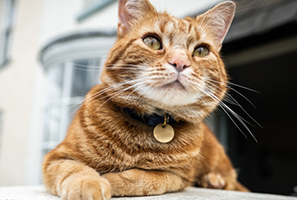Since June 2024, it’s been a legal requirement in England for all cats aged 20 weeks and over to be microchipped. Here’s what you need to know about this painless yet essential procedure.
Microchipping cats: everything you need to know
.jpeg)
Quick Links
Do cats have to be microchipped?
Cat microchipping is now a legal requirement in England.
Before microchipping became mandatory, eight out of 10 cats handed into adoption centres in England weren’t chipped, which made it much harder for them to be reunited with their owners. New microchipping laws should increase the chances of identifying lost pets, such as if they go missing or are stolen.
What happens if I don't microchip my cat?
Failure to microchip your cat in England may result in a fine of up to £500 – though you’ll be given 21 days to rectify the situation.
Cat microchipping isn’t yet mandatory in Scotland, Wales or Northern Ireland, but it’s still a good idea in case your cat goes missing.
How does microchipping work?
A microchip is a small electronic device, roughly the size of a grain of rice. It’s implanted like an injection under your cat’s skin, usually near the neck. Once implanted, it lasts the whole of your cat’s life.
Animal microchips contain a unique ID number that can be read by a scanner. This links to a database where the owner’s details are logged. If a cat is found, a vet will scan their body to see if they’re microchipped. The cat can then be reunited with their owner, as long as their details are up to date.
Will a microchip hurt my cat?
Implanting the microchip under your cat’s skin doesn’t require an anaesthetic, though sometimes vets may decide to microchip a cat when spaying or neutering. Microchipping is as quick and simple as a vaccination or injection.
When should I microchip my cat?
By law, kittens in England need to be microchipped before they’re 20 weeks old. It can be done at the same time your kitten has their primary vaccinations.
If you’re buying a kitten from a breeder or rehoming a cat from a rescue centre, they may already be microchipped, so all you need to do is transfer ownership details on the database.
How do I register my cat’s microchip?
Your vet, or the place where your cat was chipped, will log your details with one of the approved databases. In the UK, there are around 20 databases that register different brands of microchips. The registration details will be passed to you.
Think of microchip registration like the number plate on a vehicle – it’s a unique ID number that identifies the registered owner. Just like with cars, it’s a legal requirement to keep your details up to date. If your phone number or address changes, or your cat is rehomed, you’ll need to update the details.
Failure to update owner contact details is a major reason why cats who have been microchipped aren’t reunited with their owners. According to the UK’s Chief Veterinary Officer, Dr Christine Middlemiss: ‘Microchipping is by far the most effective and quickest way of identifying lost pets. As we’ve seen with dog microchipping, cats who are microchipped are more than twice as likely to be reunited with their owner.’
Where can I get my cat microchipped?
Usually, you’ll get your cat microchipped at the vet when taking them for their vaccinations or neutering. However, some charities – such as Cats Protection, the Edinburgh Dog and Cat Home, Blue Cross and Battersea Dogs & Cats Home – will also microchip your cat for you.
If you have cat insurance with Petplan, use our free Pet Expert Chat feature to connect with professionals and ask for advice on the best way to microchip your cat.
How much does microchipping a cat cost?
The cost of microchipping a cat is typically around £20 to £30. If you adopt a cat from Cats Protection or other rehoming charities, the cost of microchipping cats is included in your adoption fee, along with a health check, worming and vaccinations.
How can a microchip help you keep your cat safe?
Cats like to wander, which means they have a greater chance of getting lost. This also increases their risk of injury from incidents such as traffic accidents.
Injured pets are often brought into vets’ surgeries by people who have found them, and if cats don’t have a microchip, there’s no way of identifying them. If vets are unable to contact the owners, they’re often left in a difficult position: while they can alleviate a pet’s pain if they’re injured, they haven’t been given the owner’s permission to perform advanced treatments, such as surgery. It’s distressing for both the pet and the vet.
Do indoor cats need microchipping?
Yes, the law in England means all pet cats must be microchipped. This also helps if your cat escapes – for example, if you’re moving house or if a guest lets your pet out by mistake.
Do older cats have to be microchipped?
All cats in England must be microchipped by law, regardless of age.
Can you transfer pet microchip ownership?
To transfer the ownership of your cat’s microchip, you’ll need to contact your respective microchip company and ask how to go about it. Sometimes you can do this directly on their website by filling in forms.
In order to update details, you’ll need your cat’s microchip number and the details of the new owner or address that you’d like to update.
What to do if my cat goes missing?
Sadly, cats can sometimes go missing. If this happens to you, contact the database, register your cat as missing and make sure your details are up to date.
Petplan is a trading name of Pet Plan Limited (Registered in England No. 1282939) and Allianz Insurance plc (Registered in England No. 84638), Registered office: 57 Ladymead, Guildford, Surrey GU1 1DB.
Pet Plan Limited is authorised and regulated by the Financial Conduct Authority. Financial Services Register No. 311969. Allianz Insurance plc is authorised by the Prudential Regulation Authority and regulated by the Financial Conduct Authority and the Prudential Regulation Authority. Financial Services Register No. 121849. Pet Plan Limited is a subsidiary of Allianz Insurance plc.





